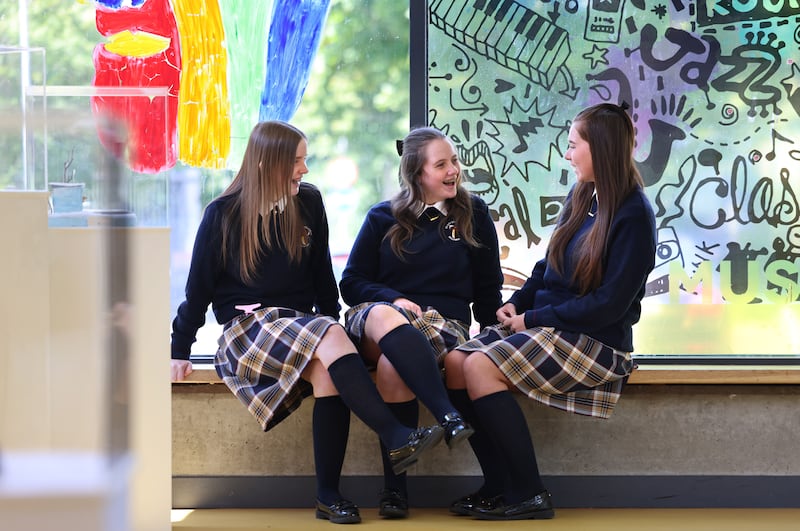The first of this year’s Leaving Cert exams was accessible and included universal themes, with English paper one students guided through the paper by specific prompts, teachers said.
A record number of students – 136,000 – were set to begin the Junior Cycle and Leaving Cert exams on Wednesday.
Kate Barry, a teacher at Loreto Secondary School in Cork, said the higher-level paper gave students a lot of direction, compared with previous years.
“The question A comprehensions provided direction around marks and the amount of points they should give for each question,” said Ms Barry, a subject representative with the Association of Secondary Teachers Ireland (ASTI).
READ MORE
Clodagh Havel, an English teacher at the Institute of Education, said some of these prompts were more specific than expected, but that students would have lots of room to explore and expand in their answers.
The paper focused on the theme of connections and, overall, students would have been very satisfied with its accessibility, said Laura Daly, a teacher at St Benildus College in Dublin and subject expert with Studyclix.
This year’s paper gave students a choice of three comprehension texts.
They included an article by Irish Times journalist Fintan O’Toole, published in January 2023, on how an appreciation of the natural world can also help build connections between people; an extract from The Bee Sting, the Booker Prize-nominated novel by Irish author Paul Murray; and an article from Financial Times journalist Monisha Rajesh on how travel can help us to build connections.
“English paper one sets the mood for the exams,” Ms Havel said. “The paper’s theme ‘connections’ was universal enough to allow students to draw in a wide variety of experiences while also sufficiently rooted in their world to give them something that they could really get their teeth into.”

Ms Daly, however, said that some of the part B questions were underwhelming.
“This was due to their lack of creativity,” she said. “Students had the option of composing a series of diary entries, a style reminiscent of more traditional examinations, and seen commonly at Junior Cycle level. Additionally, the paper included a dialogue and a proposal for a Tidy Towns committee.
“Notably absent were contemporary formats like blogs or podcasts, which could have provided a modern touch. Nevertheless, the absence of novel or excessively demanding tasks in this section would likely have been met with approval by the students.”
As for the essay questions, Ms Barry said some of the students may have been thrown by a question asking them to write a dialogue, but that they had other options.
The afternoon’s higher-level Leaving Cert home economics paper was described as fair, but parts of it were challenging.
“It was a fair reflection of a living subject,” said Sandra Cleary, a teacher at the Institute of Education. “Students leaving the exam hall today will likely be happy, satisfied that whatever work they did will have been fairly represented. The paper rewarded those with a forensic engagement with past papers and the curriculum.”
Linda Dolan, Studyclix.ie subject expert and a home economics teacher at Mercy College, Sligo, said the paper was fair but challenging in parts.
“The anticipated topic of carbohydrates hadn’t reared its head since 2017, but appeared in question one, which would have left teachers and students relieved.
“The manufacture of food products was a common trend in this year’s paper as the manufacture of yoghurt came up in question three, and the stages in the production of oil was seen in the core question four. This focus on food production and technology was also popular in last year’s short questions.”
In the Junior Cycle, meanwhile, students faced a challenging start to the exam with the two-hour English paper examining a wide range of topics and skills, teachers said.
“As always students would have found the timing of the higher-level exam challenging,” said Ms Daly.
“All four main studied topics appeared – Shakespeare and an option of the novel in section A, and poetry and film studies in Section C. Unseen poetry did not appear, probably to the relief of many candidates,” she said.
Ms Barry said the paper was in line with previous years.
“Students would be happy enough, and there was good choice,” she said. “But the course is much bigger than the old Junior Cert, so it is difficult to cover topics in a lot of depth. It would make more sense to cover fewer areas, in more depth.
“This is the second year in a row where candidates sitting the exam did not have to answer a question on the only compulsory topic, Shakespeare; instead, they had to choose between Shakespeare and their studied novel.”
Try this one at home:
English, paper one, higher level
In The Bee Sting, by Paul Murray, the character Cass describes people who “would stare at her a moment as if trying to solve a puzzle”. Write a personal essay in which you reflect on some of the aspects of life you find puzzling.
- Follow The Irish Times education section on Facebook and X (Twitter) and stay up to date














